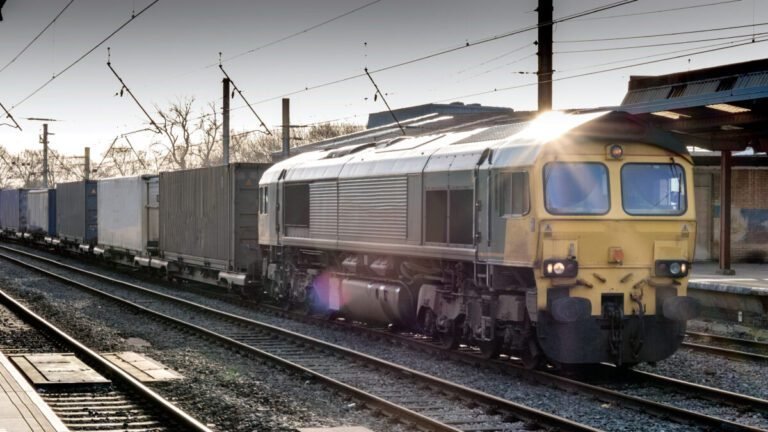The European Union has an ambitious target to increase the share of railways in freight transport to 30% by 2030 in order to reduce greenhouse gas emissions. To do this, Europeans are seeking to incorporate technological advances and develop inland port infrastructure that will support more rail freight volumes.
As Europeans undertake these efforts, North America’s freight rail system will have plenty of opportunities to learn from its European counterparts, according to two partners at global consulting firm McKinsey.
In Europe and North America, the trucking industry is exploring both battery technology, autonomous vehicles, and electric vehicles. But “the Europeans seem to be a little ahead, both in terms of regulation and technology adoption, on some EV components,” Dilip Bhattacharjee, a Chicago-based McKinsey partner, told FreightWaves.
Europeans may try to adopt battery technology components for bars before their North American peers because the regulatory framework there will allow for faster adoption, according to Bhattacharjee.
“European railways are likely to move faster than North America, because of the structure of the industry (and) because of regulation there,” Bhattacharjee said. “There is a lot for our railroads to watch and learn about how to implement these trends.”
Europeans could deploy autonomous railway technology before North America. Like North American railways, European railways will need to compete against self-driving trucks, especially on the intermodal side, Bhattacharjee said.
“The average length of distance in Europe is already lower than the average length of distance in the United States, (so) the necessity of finding a competitive response will naturally be higher in Europe than in North America,” Bhattacharjee said.
Europe is ahead of North America when it comes to the use of digital signage systems because the European rail system is heavily used by commuter rail, according to Anselm Ott, a senior McKinsey expert based in Germany in Düsseldorf.
“North America has taken a big step forward with positive train control (PTC), but I think it’s still a little behind Europe,” Ott said, where current discussions are looking at digital signaling systems for the next 20 years. PTC and digital signaling systems are technologies aimed at making rail transportation safer.
Europe is also working on digital automatic coupling, which would enable better train control and allow full data transparency about what is happening with each freight car. If this technology is adopted in the next five to 10 years in Europe, North American railroads could copy or adapt similar practices, Ott said.
Similar but different
As freight rail systems in Europe and North America incorporate more technological sophistication into their networks, both locations are grappling with similar market dynamics.
Both places serve populations where consumer demand is growing, and as a result, supply chains evolve to serve consumer demand. This means that the railways are not only grappling with competition from LTL service providers, but are also seeking to develop inland ports to serve intermodal rail service.
“One area where we should expect to see a similar response in North America, just as the Europeans have done, is to find more ways to create intermodal inland ports because the more intermodal inland ports it makes railways more competitive,” he said. Bhattacharjee said.
At the same time, the Europeans are seeking to replicate the productivity of North American intermodal trains, which can carry up to 200 intermodal containers, he added.
The EU is also seeking to double the share of rail transport to 30% by 2030 as part of wider efforts to reduce carbon dioxide emissions in the transport sector as well as reduce road congestion.
To achieve this goal by 2030, rail freight volumes in Europe will need to grow by about 6% per tonne-kilometre, or “seven times faster than road transport,” according to a January report by the European Freight Rail Network from McKinsey Company.
The report suggests focusing rail freight efforts on major transport flows, such as between Spain and central and northern Europe, as well as on connection points with major global trade ports. The report also suggests focusing on industries that could shift to rail and replace declining coal and steel volumes.
While the equipment used on European freight trains is the same as that used in North America – locomotives, basic technology, hardware and software – European freight trains operate very differently from North American freight trains.
In Europe, state-owned companies operate freight railways, while in North America, railways are private companies.
Another major difference is that anyone with a valid railway license can operate a train, so some railway systems, such as the German railway system, can operate as a toll road or motorway where railway companies pay a fee to use the railway system, out He said.
“A company can’t start a company and run freight trains on the BNSF or Union Pacific lines. That’s one of the main differences. In Europe, I can do that,” Ott said.
Furthermore, Europe’s railway system is mostly used by passenger railways and, as a result, freight trains run on networks with more frequent and shorter tracks.
“Markets like India, Egypt and Europe are largely passenger rail markets, where freight is almost secondary and has to be included,” Bhattacharjee said.
European freight train lengths are also much shorter. Container trains are also single-stacked and not double-stacked like North American trains.
“Because the supply chains in each of those markets have evolved differently, the actual regulatory environment, as well as the industry structure, have naturally evolved into very different operating models,” Bhattacharjee said.
Sign up for FreightWaves e-newsletters and get the latest shipping insights straight to your inbox.
Click here for more FreightWaves articles by Joanna Marsh.





